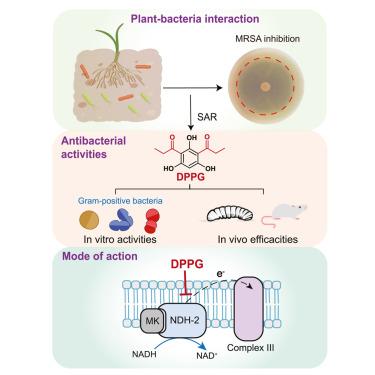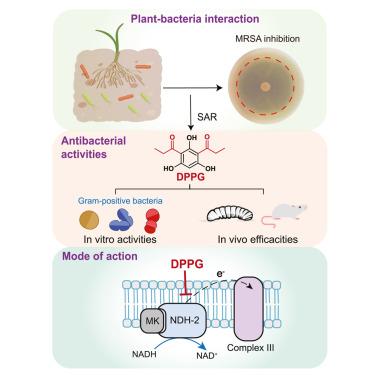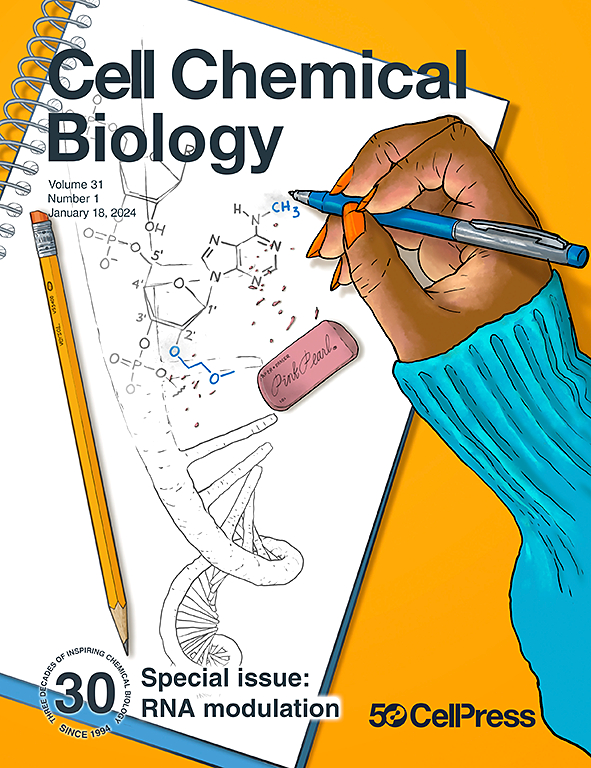Discovery of antibacterial diketones against gram-positive bacteria
IF 6.6
1区 生物学
Q1 BIOCHEMISTRY & MOLECULAR BIOLOGY
引用次数: 0
Abstract
The rapid rise of antibiotic resistance calls for the discovery of new antibiotics with distinct antibacterial mechanisms. New target mining is indispensable for developing antibiotics. Plant-microbial antibiotics are appealing to underexplored sources due to a dearth of comprehensive understanding of antibacterial activity and the excavation of new targets. Here, a series of phloroglucinol derivatives of plant-root-associated Pseudomonas fluorescens were synthesized for structure-activity relationship analysis. Notably, 2,4-diproylphloroglucinol (DPPG) displayed efficient bactericidal activity against a wide range of gram-positive bacteria. Importantly, mechanistic study exhibits that DPPG binds to type II NADH dehydrogenase (NDH-2), an essential enzyme catalyzing the transfer of electrons from NADH to quinones in the electron transport chain (ETC), blocking electron transfer in S. aureus. Last, we validated the efficacy of DPPG in vivo through animal infection models. Our findings not only provide a distinct antibiotic lead to treat multidrug resistant pathogens but also identify a promising antibacterial target.


发现针对革兰氏阳性细菌的抗菌二酮。
抗生素耐药性的迅速增加要求发现具有独特抗菌机制的新型抗生素。开发抗生素离不开新靶点的挖掘。由于缺乏对抗菌活性的全面了解和新靶点的挖掘,植物微生物抗生素对未充分开发的来源具有吸引力。本文合成了一系列与植物根相关的荧光假单胞菌的氯葡萄糖醇衍生物,并对其进行了结构-活性关系分析。值得注意的是,2,4-二丙基氯葡萄糖醇(DPPG)对多种革兰氏阳性菌具有高效的杀菌活性。重要的是,机理研究表明,DPPG 与 II 型 NADH 脱氢酶(NDH-2)结合,阻断了金黄色葡萄球菌体内的电子传递。最后,我们通过动物感染模型验证了 DPPG 在体内的疗效。我们的研究结果不仅为治疗耐多药病原体提供了一种独特的抗生素线索,还发现了一个很有前景的抗菌靶点。
本文章由计算机程序翻译,如有差异,请以英文原文为准。
求助全文
约1分钟内获得全文
求助全文
来源期刊

Cell Chemical Biology
Biochemistry, Genetics and Molecular Biology-Molecular Medicine
CiteScore
14.70
自引率
2.30%
发文量
143
期刊介绍:
Cell Chemical Biology, a Cell Press journal established in 1994 as Chemistry & Biology, focuses on publishing crucial advances in chemical biology research with broad appeal to our diverse community, spanning basic scientists to clinicians. Pioneering investigations at the chemistry-biology interface, the journal fosters collaboration between these disciplines. We encourage submissions providing significant conceptual advancements of broad interest across chemical, biological, clinical, and related fields. Particularly sought are articles utilizing chemical tools to perturb, visualize, and measure biological systems, offering unique insights into molecular mechanisms, disease biology, and therapeutics.
 求助内容:
求助内容: 应助结果提醒方式:
应助结果提醒方式:


